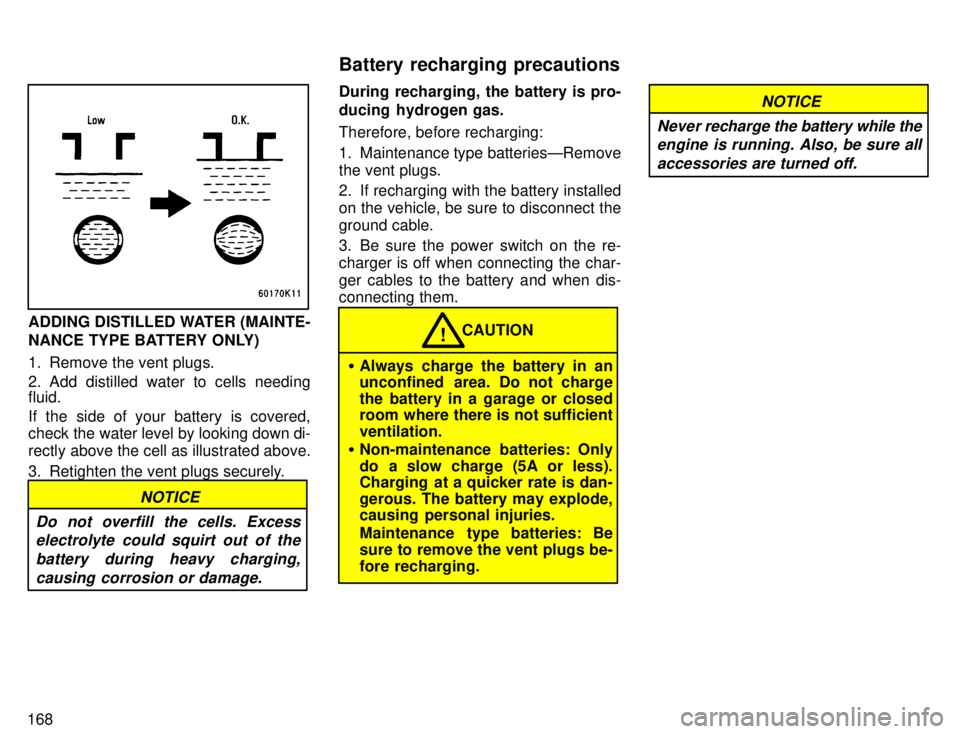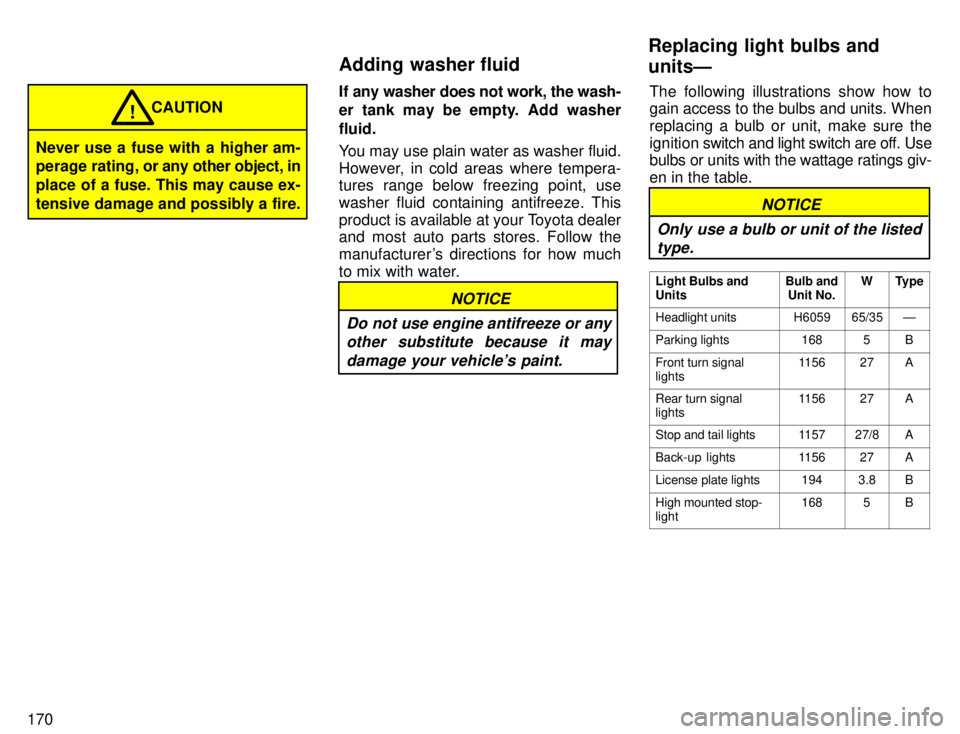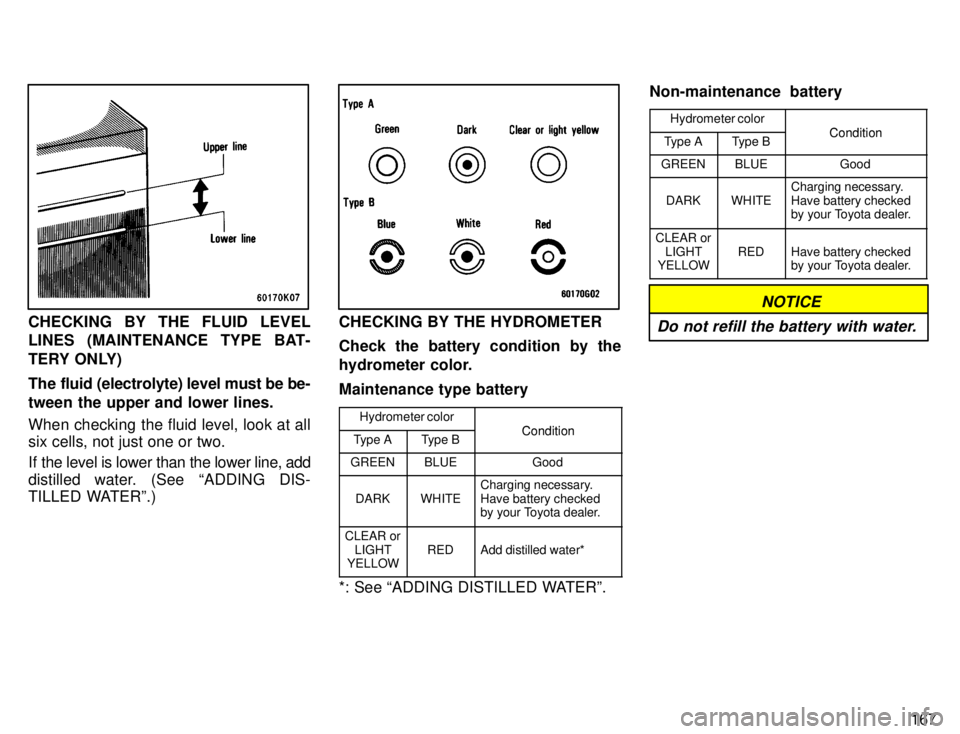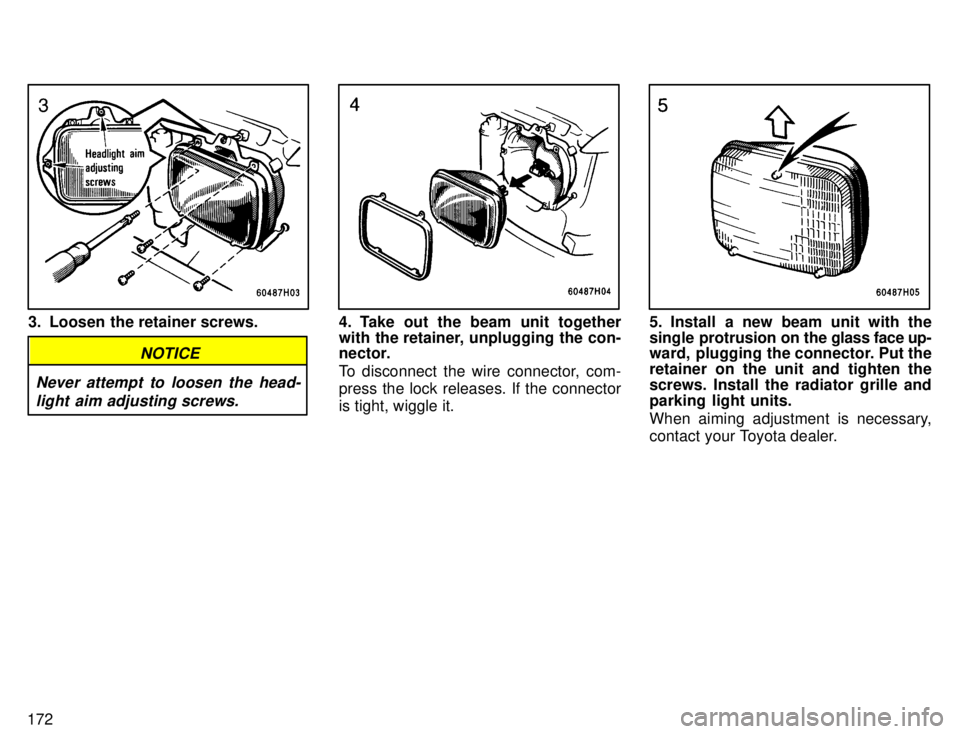TOYOTA TACOMA 1996 Owners Manual
TACOMA 1996
TOYOTA
TOYOTA
https://www.carmanualsonline.info/img/14/68795/w960_68795-0.png
TOYOTA TACOMA 1996 Owners Manual
Trending: coolant level, charging, lug pattern, oil level, fuel pump, height, air filter
Page 171 of 196
167
CHECKING BY THE FLUID LEVEL
LINES (MAINTENANCE TYPE BAT-
TERY ONLY)
The fluid (electrolyte) level must be be-
tween the upper and lower lines.
When checking the fluid level, look at all six cells, not just one or two.
If the level is lower than the lower line, add
distilled water. (See ADDING DIS-
TILLED WATERº.)CHECKING BY THE HYDROMETER Check the battery condition by the
hydrometer color. Maintenance type batteryHydrometer color
ConditionType AType BCondition
GREENBLUEGood
DARKWHITECharging necessary. Have battery checked
by your Toyota dealer.
CLEAR orLIGHT
YELLOWREDAdd distilled water*
*: See ADDING DISTILLED WATERº. Non-maintenance battery
Hydrometer color
ConditionType AType BCondition
GREENBLUEGood
DARKWHITECharging necessary. Have battery checked
by your Toyota dealer.
CLEAR orLIGHT
YELLOWREDHave battery checked
by your Toyota dealer.
NOTICE
Do not refill the battery with water.
Page 172 of 196

168
ADDING DISTILLED WATER (MAINTE-
NANCE TYPE BATTERY ONLY)
1. Remove the vent plugs.
2. Add distilled water to cells needing fluid.
If the side of your battery is covered,
check the water level by looking down di-
rectly above the cell as illustrated above.
3. Retighten the vent plugs securely.
NOTICE
Do not overfill the cells. Excess electrolyte could squirt out of the
battery during heavy charging,causing corrosion or damage.
During recharging, the battery is pro-
ducing hydrogen gas. Therefore, before recharging:
1. Maintenance type batteriesÐRemove the vent plugs.
2. If recharging with the battery installed on the vehicle, be sure to disconnect theground cable.
3. Be sure the power switch on the re-
charger is off when connecting the char-ger cables to the battery and when dis-
connecting them.
� Always charge the battery in an
unconfined area. Do not charge
the battery in a garage or closed
room where there is not sufficient ventilation.
� Non-maintenance batteries: Only
do a slow charge (5A or less).
Charging at a quicker rate is dan- gerous. The battery may explode,
causing personal injuries.
Maintenance type batteries: Be sure to remove the vent plugs be-fore recharging. CAUTION
!
NOTICE
Never recharge the battery while the
engine is running. Also, be sure all
accessories are turned off.
Battery recharging precautions
Page 173 of 196

169
If the headlights or other electrical
components do not work, check the
fuses. If any of the fuses are blown,
they must be replaced.
See Fuse locationsº in Chapter 7-1 for
locations of the fuses.
Turn the ignition switch and inopera-
tive component off. Pull a suspected
fuse straight out and check it. Determine which fuse may be causing the
problem. The lid of the fuse box shows the name of the circuit for each fuse. See Part8 of this manual for the functions con-
trolled by each circuit.
Type A fuses can be pulled out by using the pull-out tool. The location of the pull- out tool is shown in the illustration. If you are not sure whether the fuse has
blown, try replacing the suspected fuse with one that you know is good.
If the fuse has blown, push a new fuse
into the clip.
Only install a fuse with the amperage rat-
ing designated on the fuse box lid.
If you do not have a spare fuse, in an
emergency you can pull out the CIGº,
RADIOº, DOMEº or A.Cº fuse, whichmay be dispensable for normal driving, and use it if its amperage rating is the same.
If you cannot use one of the same amper-
age, use one that is lower, but as close as
possible to the rating. If the amperage is
lower than that specified, the fuse might
blow out again but this does not indicate
anything
wrong. Be sure to get the correct
fuse as soon as possible and return the
substitute to its original clip.
It is a good idea to purchase a set of spare
fuses and keep them in your vehicle for emergencies.
If the new fuse immediately blows out, there is a problem with the electrical sys-
tem. Have your Toyota dealer correct it as
soon as possible.
Checking and replacing fuses
Page 174 of 196

170
Never use a fuse with a higher am-
perage rating, or any other object, in
place of a fuse. This may cause ex-
tensive damage and possibly a fire. CAUTION
!
If any washer does not work, the wash-
er tank may be empty. Add washer fluid.
You may use plain water as washer fluid.
However, in cold areas where tempera-
tures range below freezing point, use
washer fluid containing antifreeze. This
product is available at your Toyota dealer
and most auto parts stores. Follow the
manufacturer 's directions for how much
to mix with water.
NOTICE
Do not use engine antifreeze or any other substitute because it may
damage your vehicle's paint.
The following illustrations show how to
gain access to the bulbs and units. When
replacing a bulb or unit, make sure the
ignition switch and light switch are off. Use
bulbs or units with the wattage ratings giv-
en in the table.
NOTICE
Only use a bulb or unit of the listed type.
Light Bulbs and
UnitsBulb and Unit No.WType
Headlight unitsH605965/35Ð
Parking lights1685B
Front turn signal lights115627A
Rear turn signal lights115627A
Stop and tail lights115727/8A
Back-up lights115627A
License plate lights1943.8B
High mounted stop- light1685B
Adding washer fluid Replacing light bulbs and unitsÐ
Page 175 of 196
171
Light
Bulbs and
Units
Bulb and Unit No.WType
Interior light Normal cab Xtra-cabÐ Ð5
10C C
Personal lightsÐ5C
Door courtesy lightsÐ3C
Glovebox lightÐ1.4B
A: Single end bulbs
B: Wedge base bulbs
C: Double end bulbs
1. Loosen the parking light unit re-
taining screws and remove the units
unplugging the connectors.2. Open the hood. Release the clips
and remove the radiator grille.
The clips can be released with a flat-
blade screwdriver as shown.
ÐHeadlight units
Page 176 of 196
172
3. Loosen the retainer screws.
NOTICE
Never attempt to loosen the head- light aim adjusting screws.
4. Take out the beam unit together
with the retainer, unplugging the con-
nector.
To disconnect the wire connector, com-
press the lock releases. If the connectoris tight, wiggle it.5. Install a new beam unit with the
single protrusion on the gl ass face up-
ward, plugging the connector. Put the
retainer on the unit and tighten thescrews. Install the radiator grille and
parking light units.
When aiming adjustment is necessary,
contact your Toyota dealer.
Page 177 of 196
173
Use a Phillips-head screwdriver.Removing cover clips
Installing cover clips
ÐParking lights
Page 178 of 196
174
Use a Phillips-head screwdriver.Use a Phillips-head screwdriver.
a: Rear turn signal light
b: Stop and tail light
c: Back- up light
ÐRear turn signal, stop and tail, and back-up lightsÐLicense plate lights (type A)
ÐFront turn signal lights
Page 179 of 196
175
Use a Phillips-head screwdriver.Use a Phillips-head screwdriver.
ÐLicense plate lights (type B) ÐHigh mounted stoplight
Page 180 of 196
Trending: battery, inflation pressure, fuses, fold seats, heating, turn signal, height



















